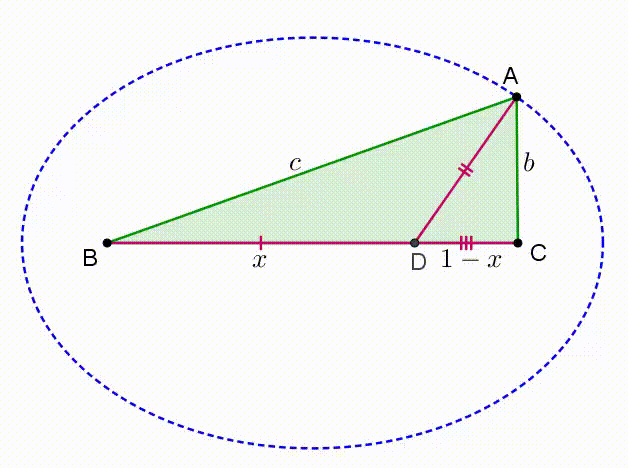Midpoint placement problem
In a triangle , and there is exactly one point on the side such that . Determine he sum of all possible values of the perimeter of the triangle .
The answer is 2.414.
This section requires Javascript.
You are seeing this because something didn't load right. We suggest you, (a) try
refreshing the page, (b) enabling javascript if it is disabled on your browser and,
finally, (c)
loading the
non-javascript version of this page
. We're sorry about the hassle.
Denote the length of B D by x . Then, D C = 1 − x . Let A B = c , A C = b , B C = a = 1 . It is given that there is a unique value for
x
, such that
A
D
2
=
B
D
⋅
D
C
⇔
A
D
2
=
x
(
1
−
x
)
(
1
)
By
Stewart’s theorem
,
It is given that there is a unique value for
x
, such that
A
D
2
=
B
D
⋅
D
C
⇔
A
D
2
=
x
(
1
−
x
)
(
1
)
By
Stewart’s theorem
,
A C 2 ⋅ B D + A B 2 ⋅ D C = ( B D + D C ) ( B D ⋅ D C + A D 2 ) ⇒ b 2 x + c 2 ( 1 − x ) = x ( 1 − x ) + A D 2 ⇒ ( 1 ) b 2 x + c 2 ( 1 − x ) = x ( 1 − x ) + x 2 2 x 2 + ( b 2 − c 2 − 2 ) x + c 2 = 0 ( 2 ) If there were two different values of x satisfying ( 2 ) , the discriminant of the quadratic equation would be positive. This is not the case, thus,
Δ = 0 ⇔ ( b 2 − c 2 − 2 ) 2 − 8 c 2 = 0 ⇔ ( b 2 − c 2 − 2 ) 2 = 8 c 2 ⇔ b 2 − c 2 − 2 = ± 2 2 c ⇔ b 2 = ( c ± 2 ) 2 ⇔ b = ± ( c ± 2 ) ( 3 ) By Triangle Inequality , it holds that ∣ b − c ∣ < a ⇒ ∣ b − c ∣ < 1 , hence ( 3 ) gives only one acceptable relation for positive b and c : b + c = 2 This means that there is only one possible perimeter for △ A B C : a + b + c = 1 + 2 ≈ 2 . 4 1 4